Author: info@discoverdairy.com
Irish Dairy Facts to Share for St. Patrick’s Day
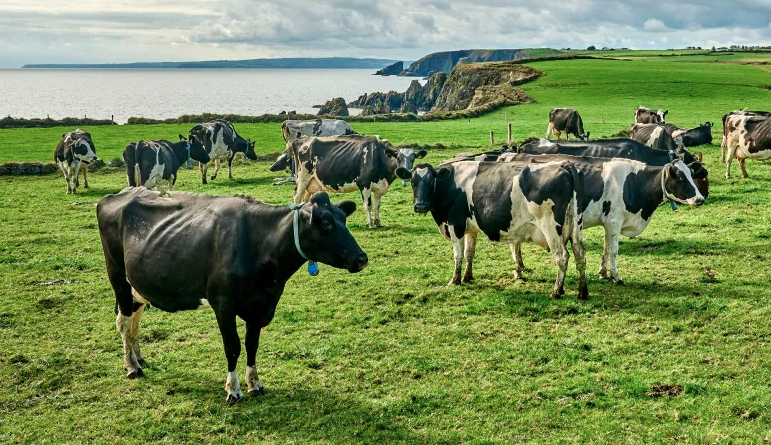
If you’re celebrating St. Patrick’s Day on March 17, try sharing some of these Irish “Dairy Fun Facts” with your students. Did you know Ireland has 1.5 million cows? The dairy industry is very strong and important to their heritage, just like it is in the United States. Click here to view more Irish dairy fun facts.
Age group? These facts are ideal for students of all ages, depending on how you introduce them.
Dairy Fun Fact: Milk Is 87% Water
Did you know milk is 87 percent water? This is a relevant statistic to share with your students as you celebrate National Water Day and Nutrition Month using this week’s Sunday Funday activities! With milk being filled with so much water, that’s why cows drink a lot of water on a daily basis. They actually drink more than a bathtub full of water each and every day!
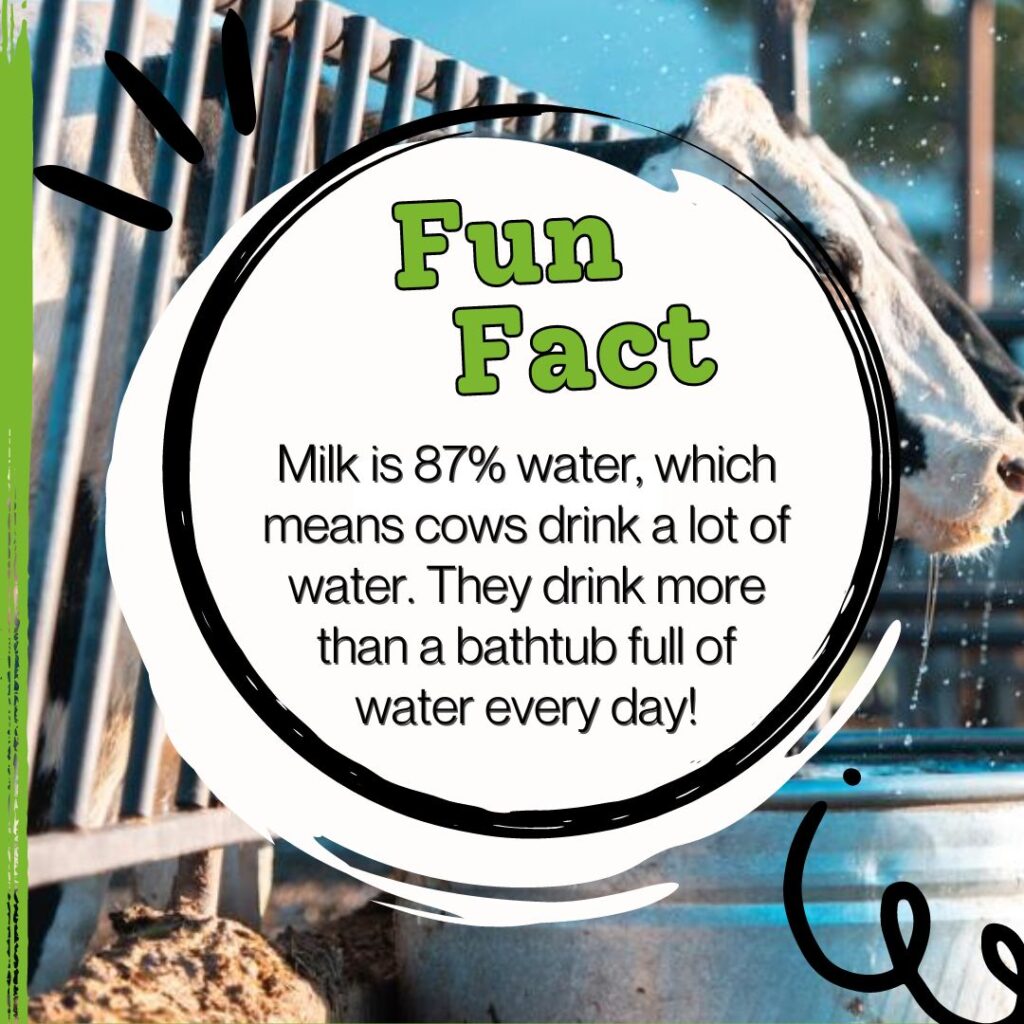
Shamrock Shaped Havarti Cheese Display for St. Patrick’s Day
| Try this festive Shamrock Shaped Havarti Cheese Display for a St. Patrick’s Day inspired snack board in or out of the classroom. |
| Directions 1. Find a 20″ x 14.5″ wood-framed chalk board. Hobby Lobby or other craft stores may have one. Rub it with food-safe beeswax to use for serving. 2. Start by making a shamrock for the middle of the board out of Havarti dill cheese or a similar type of cheese. 3. Take 3 slices and cut each one with a heart-shaped cookie cutter. Then, press each heart into a plate of finely cut fresh dill to make it more green before placing them together in the middle of the board to form the shamrock shape. 4. Use one of the cheese scraps to form the “stem.” 5. Finish your cheese display by putting various meats, veggies, fruits, dips, spreads, etc. on your board. |
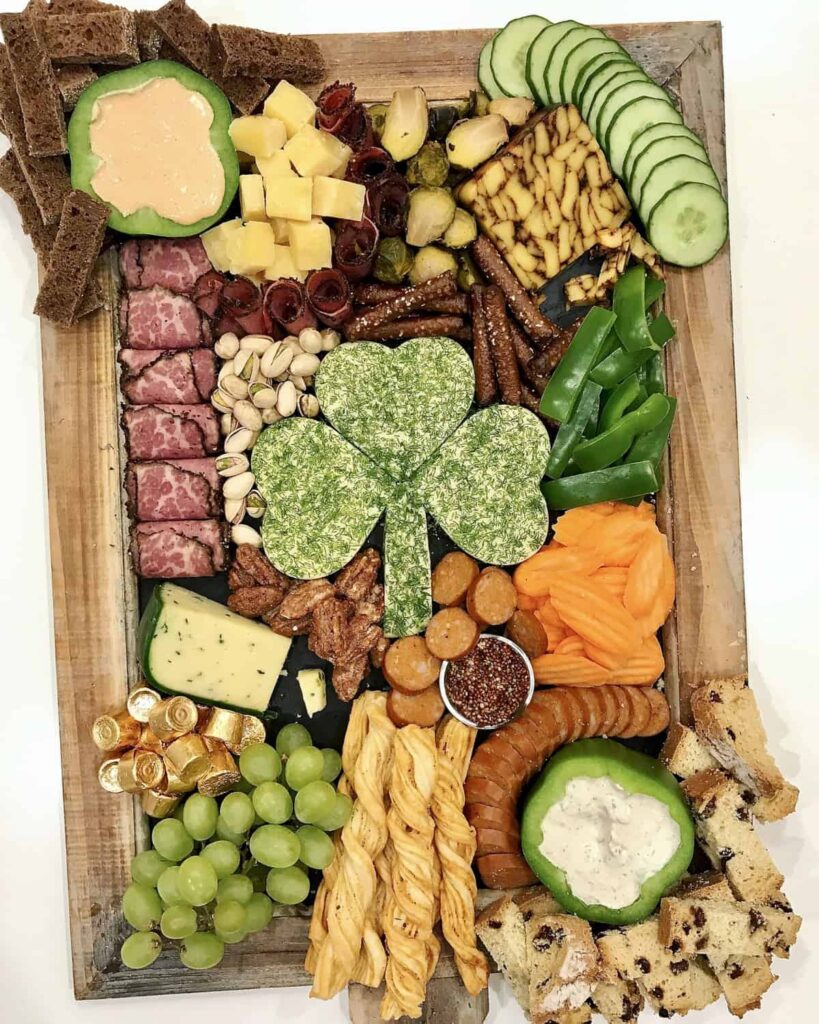
Make a Craft & Watch Your Farm Tour Video
Have you watched your Adopt a Cow Farm Tour video yet with your host farm? These videos are all available on our YouTube channel! This kindergarten class watched their farm tour video and made a fun cow headband craft to go along with the viewing experience.

“My kindergarten class loves learning about our adopted cow Margie and Long Green Farm. We watched the farm tour video and the students kept looking for Margie. As a class craft, each student made a cow headband so they could look like the cows in the video,” shared Melissa, their teacher.
New Dairy-Focused Animal Health Lessons Available for Elementary and Middle School Teachers
The Lessons Are Available At No Cost to Teachers Who Sign Up for the Discover Dairy Program
Discover Dairy, a multi-level lesson series, has several free dairy-focused lessons available for teachers and students in a variety of learning environments, including traditional classrooms and home school settings. A new Animal Health lesson, focused on helping students explore the career of dairy farming and how farmers care for their cows, was recently published for the following grade levels: kindergarten to second grade, third to fifth grade, and sixth to eighth grade. There are four other dairy lessons available at no cost on the Discover Dairy website, with additional lessons expected to be released in the fall of 2024.
Managed by the Dairy Excellence Foundation of Pennsylvania and its partners, Discover Dairy is an interactive cross-curricular, multi-level lesson series that meets Pennsylvania state education standards and anchors for science, math and reading. The program also incorporates social studies concepts to show students where milk comes from and how dairy farms contribute to our world. The lessons include video motivators, reading guides, lab resources, assessment-based worksheets, and more.
“Discover Dairy was created to bring the dairy farm into the classroom. These lessons are not only informative, but we’ve worked hard to make them interactive and engaging for students at all grade levels. With a variety of hands-on labs and activities, students begin to understand all the ways that dairy farming connects to their communities and the foods they consume on a daily basis,” said Brittany Snyder, Dairy Education Program Manager at the Dairy Excellence Foundation. “We’re excited to launch the new Animal Health lessons this spring and release additional lessons in the fall to share the world of dairy farming with even more classrooms.”
The following lessons are available to teachers on the Discover Dairy website:
- Animal Health – Students learn about the career of dairy farming and how dairy farmers care for their cows to ensure they are healthy and comfortable.
- Milk Quality & Safety – Students will learn the steps that milk goes through from the farm to the grocery store to ensure safe and high-quality dairy products.
- Dairy In Our Environment – Students will learn about the importance of connecting the farmer, the consumer and the environment. They will understand the roles dairy farmers fill in protecting the environment such as recycling.
- Dairy In Our Community – Students will learn how dairy farms contribute and impact consumers, retailers, and communities. They will also discover how milk and farm products come from healthy, natural resources.
- Dairy and Good Nutrition – Students will learn how choices affect their diet, health and nutrition. They will then explore the number of servings needed from each food group in the “MyPlate” Food Guidelines.
“I try to keep dairy in our units because there’s a lot of other science I have to cover in social studies. We can get all the standards in with dairy. I started with lesson one in Discover Dairy. We’ve learned about the chemical components of milk, that farmers don’t put antibiotics in milk, and how they take care of their cows,” said Julie Cates, a sixth-grade teacher in California. “We did an activity making butter, because we learn about homogenization and pasteurization [in the lessons]. We can bring in other sciences to supplement everything. This year was very exciting because none of my sixth-graders had ever made butter using cream. The butter-making activity is really fun because it’s so hands-on and it’s simple, too.”
Teachers can sign up for a free Discover Dairy account and have access to all lessons and activities at no cost. There are additional classroom enrichment activities offered on the platform, including dairy books, games, videos, posters, activities, virtual farm tours, and more. Discover Dairy teachers also have access to farm tour field trip grant opportunities every school year. The Adopt a Cow Program, which impacts more than one million students worldwide each school year, is a flagship component of the Discover Dairy program and another interactive learning opportunity for students.
“The Discover Dairy lessons have been really easy to follow along with. The first one was as simple as opening up the video and using the conversation questions. I appreciate that the prep work is quick, whether I’m planning three weeks in advance or the night before. I like that it’s quick to put together,” said Becky Norton, a home school teacher in Georgia. “My kids are very close in age, but for a home school family that has multiple grade levels, it would be very easy to adapt to a greater age span. In a classroom setting, teachers could pick out age-appropriate activities and do a lot of cross-curricular activities. You can pull in agriculture, math and language arts, too.”
Visit www.discoverdairy.com to create a teacher account, access the free lessons, and view the wide range of activities. To learn more about the program and how you can share it with teachers in your community, contact Brittany Snyder at bsnyder@centerfordairyexcellence.org or call 717-788-0297.
Discover Dairy is an educational series managed by the Center for Dairy Excellence Foundation of Pennsylvania in partnership with American Dairy Association Northeast, American Dairy Association Indiana, Midwest Dairy, The Dairy Alliance, Dairy Farmers of Wisconsin, Dairy Council of Arizona and Nevada, Dairy West, New England Dairy, Dairy Farmers of Washington, American Dairy Association Mideast, Dairy Council of Florida, United Dairy Industry of Michigan, Maine Dairy and Nutrition Council, and Oregon Dairy and Nutrition Council.
Sixth-Grade Teacher Brings Science and Social Studies to Life Through Dairy Connections
For Julie Cates, a sixth-grade teacher who teaches middle school curriculum in the central valley of California, the Discover Dairy and Adopt a Cow Programs have given her a creative outlet to not only meet some of her lesson standards, but help her students connect with the community around them. Through free lessons, videos and activities, her students can “adopt” a calf for the school year, watch it grow, and take their learning a step further through hands-on labs and lessons with the Discover Dairy program. Julie’s school district is located in a rural area where there are a lot of nearby dairy farms along with the production of grapes, tree nuts and citrus.
“I started using the Adopt a Cow program because it’s really important for kids to make that connection [to where their food comes from]. It’s super important to have the virtual components and videos because we can’t always do field trips,” Julie shared. “I also have kids whose parents work in the dairy industry, so it’s important for them and for their self esteem to see how valuable that is. Some of their parents are in labor positions, so it validates them to see how important their role is.”

With four Discover Dairy lessons available at the middle school level, Julie works to connect the lessons to as many subjects and concepts as she can – from social studies and science to math and language arts. For example, in their social studies unit, students learn about ancient cultures with Mesopotamia (the birthplace of agriculture), so Julie is able to connect the dairy lessons to those social studies concepts.
“I do try to keep dairy in our units because there’s a lot of other science I have to cover in social studies. We can get all the standards in with dairy,” she added. “At the beginning when we initially get our adopted cow, I start with lesson one in Discover Dairy. Some of the lessons would be great in a middle school lab, but we’re not in a lab. We’re in an all-inclusive room, so that gets a little tricky. But we learn about the chemical components of milk, that farmers don’t put antibiotics in milk, and how they take care of their cows.”
Throughout the school year, Julie also shares Discover Dairy videos with her students and inserts her own questions related to math and science. She adds a score for comprehension so she can formally assess the students and evaluate their understanding and listening skills. To add a hands-on element to the lessons and curriculum, Julie also led a butter-making activity with her sixth-graders this year.
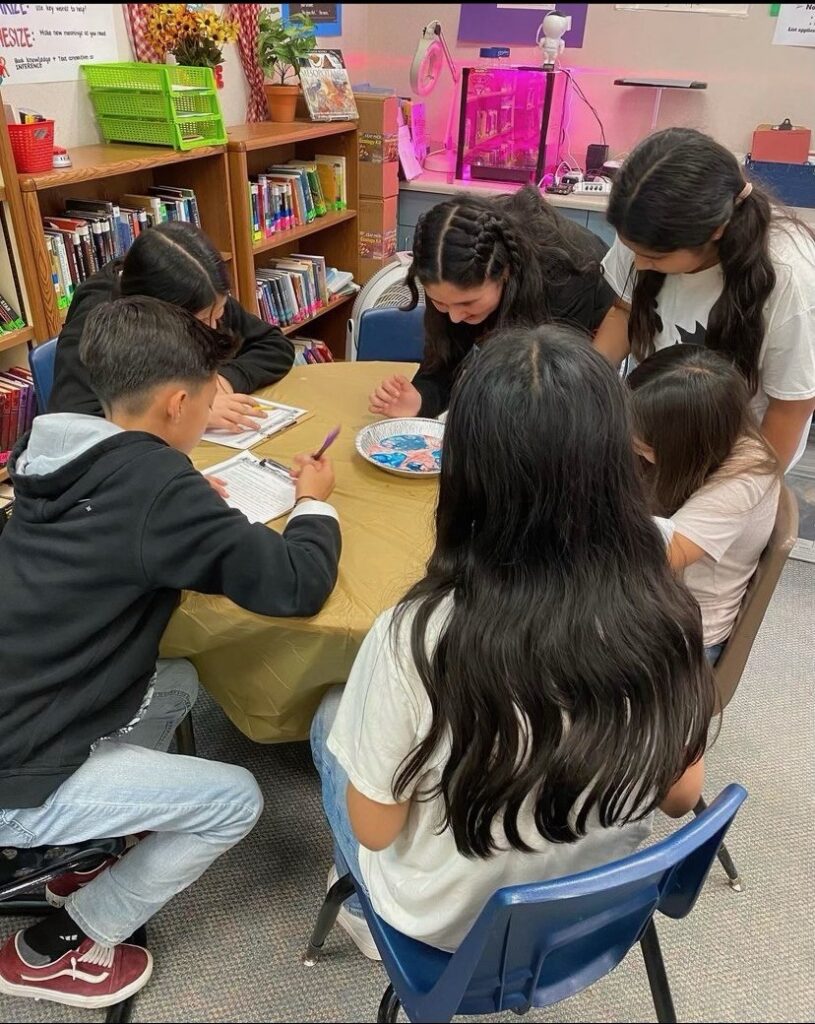
“We did an activity making butter, because we learn about homogenization and pasteurization [in the lessons]. We can bring in other sciences to supplement everything. This year was very exciting because none of my sixth-graders had ever made butter using cream, so that was a shock for them. For me, that butter-making activity is really fun because it’s so hands-on and it’s simple, too,” Julie explained.
For STEM, engineering, environmental and economic connections, she teaches her students how dairy farmers are using methane digesters and coming up with climate-smart solutions. Then, they actually have the opportunity to design their own digesters.
“In the spring, the kids create digesters and do experiments with them to see that farmers are stewards of the land,” Julie said. “California is a huge state, and we have to understand where our food comes from and how to sustain it and maintain it. I have kids who still think chocolate milk comes from chocolate cows and don’t understand that yogurt is a dairy product. From the truck drivers to the processors and the grocery store, all of those components are important to help students understand the economy, too.”

One of her favorite parts of the program is the Adopt a Cow “live chats” that happen at the end of each school year. Her class can join a live farm tour where they will meet their host farm and adopted calf, and ask questions about day-to-day life on the farm. Julie says this experience brings all the lessons they’ve learned throughout the school year full circle.
“It’s live and it’s natural, and the big cow’s face might be in the camera. It’s so fun for the kids. They just have a ball with it because it feels like they are right there [on the farm].”
Discover Dairy is an engaging, interactive, cross-curricular educational series that meets Common CORE Standards for Math, Science and Reading. This lesson series shows upper elementary and middle school students where milk comes from and how dairy farmers contribute to our world. Discover Dairy is a resource provided at no cost to educators and others who are interested in teaching students about the dairy industry.
Discover Dairy is an educational series managed by the Center for Dairy Excellence Foundation of Pennsylvania in partnership with American Dairy Association Northeast, American Dairy Association Indiana, Midwest Dairy, The Dairy Alliance, Dairy Farmers of Wisconsin, Dairy Council of Arizona and Nevada, Dairy West, New England Dairy, Dairy Farmers of Washington, American Dairy Association Mideast, Dairy Council of Florida, United Dairy Industry of Michigan, Maine Dairy and Nutrition Council, and Oregon Dairy and Nutrition Council.
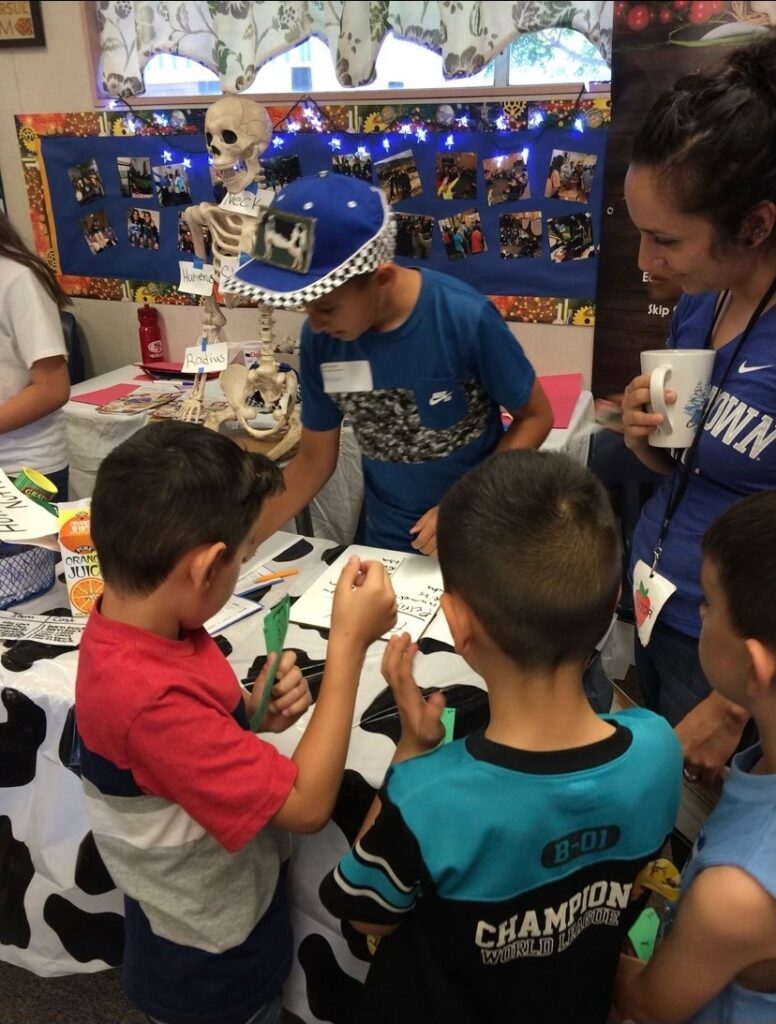
Join the Moo Cow Dance Challenge
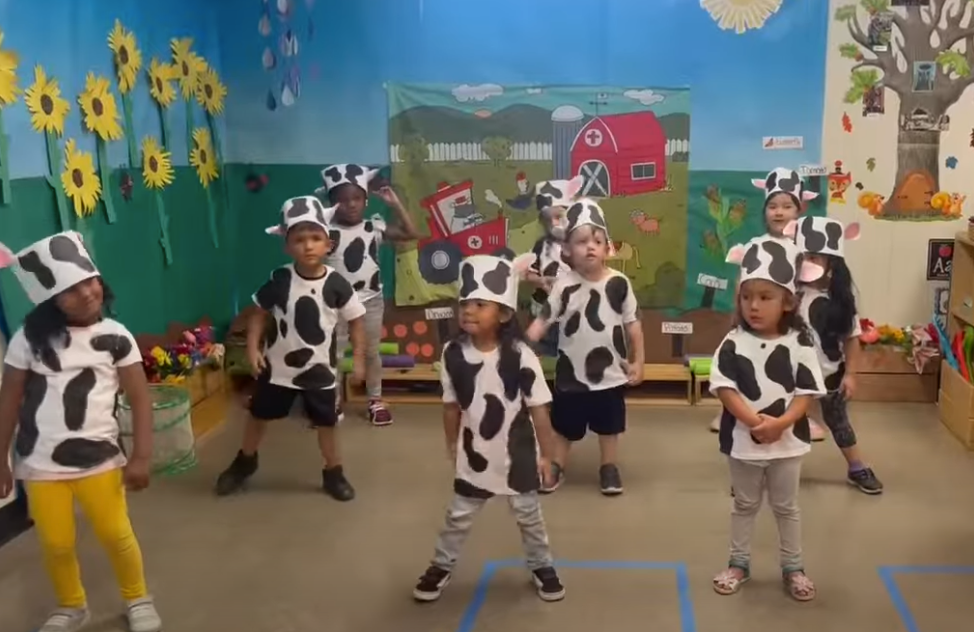
Are you looking for a fun way to get your students up and moo-ving? Check out the Moo Cow Dance Challenge! It’s a fun way to take a brain break, and you might even win an ice cream party for your classroom. Click on the links on this page to watch the video, learn the lyrics, and see the motions. Then, have your students try it on their own! To take the challenge, take a video of your students doing the Moo Cow Dance and submit it to Discover Dairy by Thursday, March 28 at 11:59 PM EST. Winners will receive cow-themed materials for a classroom ice cream party and a gift card to buy ice cream!
Age group? The Moo Cow Dance Challenge is ideal for students of all ages.
Celebrate National School Breakfast Week With Worksheet & Recipes
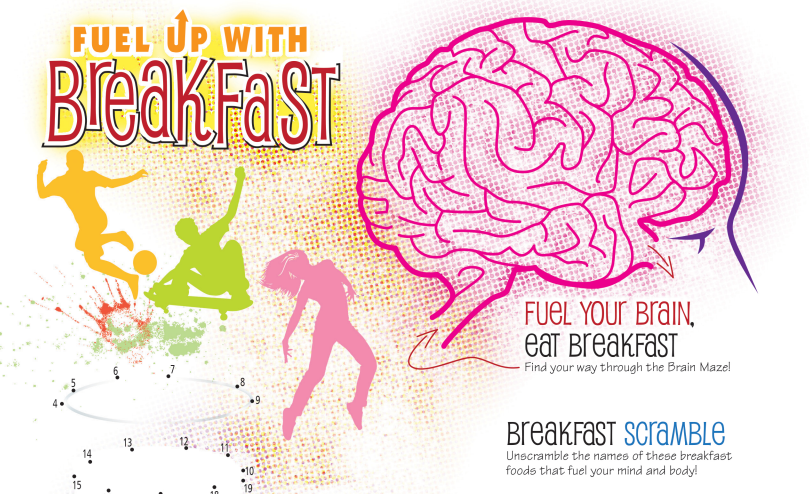
Happening on March 4-8, National School Breakfast Week (NSBW) celebrates the importance of a nutritious school breakfast in fueling students for success. This week also celebrates the national School Breakfast Program and the many ways it gives kids a great start every day. Dairy plays an important role in starting the day off strong to fuel your days! After all, it has been shown that students who eat breakfast score higher on tests.
Click here to download a fun “Fuel Up With Breakfast” worksheet to help students learn more about the importance breakfast has in their day. Age group? This worksheet is ideal for 3rd to 5th grade students.
You can also try a different breakfast recipe each day this week, all featuring different dairy products:
- March 4: Green Eggs and Ham Omelet. In honor of Dr. Seuss’ birthday, Read Across America Week is also happening this week. Celebrate with this protein-filled breakfast. View the recipe.
- March 5: Fruity Breakfast Popsicles. These breakfast popsicles combine yogurt, milk, fresh fruit and granola for a delicious treat that’s also colorful to look at. View the recipe.
- March 6: Breakfast Pizza with Cheddar Buttermilk Biscuit Crust. You can’t go wrong with breakfast pizza, especially this recipe that adds a cheddar cheese biscuit crust!View the recipe.
- March 7: Chocolate Milk Pancakes. Do your kids love pancakes and chocolate milk? Combine these two kid-friendly favorites into one delicious breakfast! View the recipe.
- March 8: Cocoa Mint Smoothie Bowl. This nutrient-packed delight brings together the irresistible combination of chocolate and mint combined with bananas, milk and more. View the recipe.
See How Dairy Farmers Use Math: Free Dairy Math Lessons Available
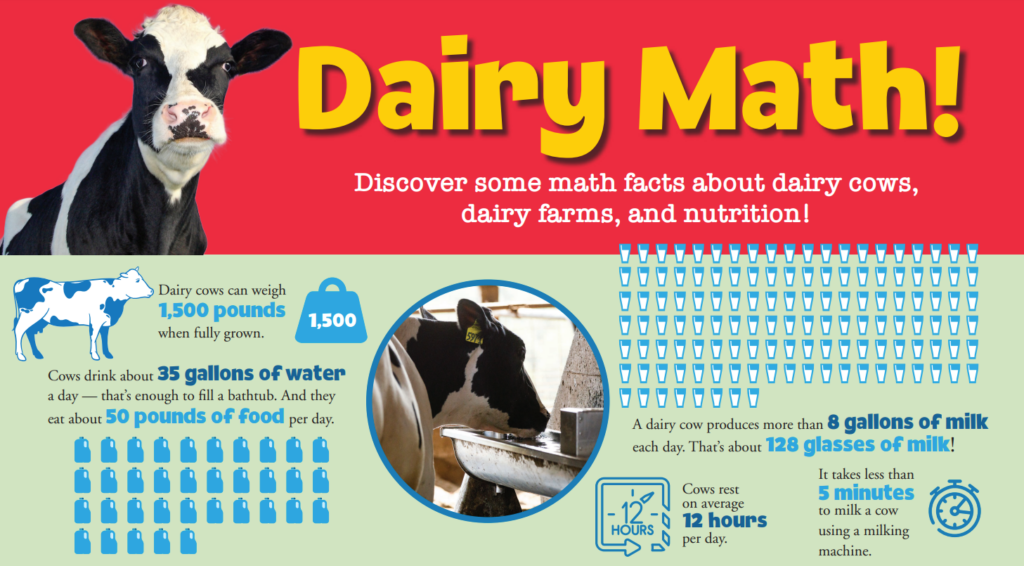
As with running any business, numbers are top of mind for dairy farmers as they calculate how much feed their herd will need to stay healthy, how many gallons of milk they will provide to school systems, restaurants, and home consumers, how much energy they can save by using technology effectively, and more. In these free Dairy Math lessons, you can challenge your students to solve math problems related to cow care and dairy farm sustainability, and then use USDA MyPlate guidelines for planning healthy meals.
Age group? These lessons are ideal for 2nd through 4th grade students.
From Farm to Fridge: Watch Dairy Foods Video
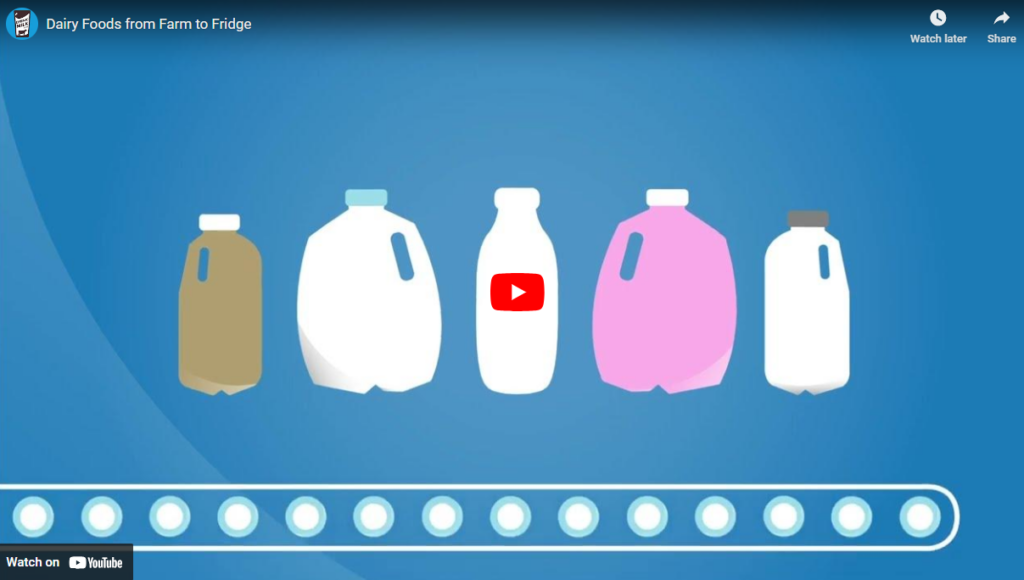
With so much focus on breakfast, dairy-packed foods, and school nutrition this week, check out this interesting, three-minute “From Farm to Fridge” video about dairy foods. Discover how dairy foods get from the cow to your glass, bowl or plate! Age group? This video is ideal for students of all ages.